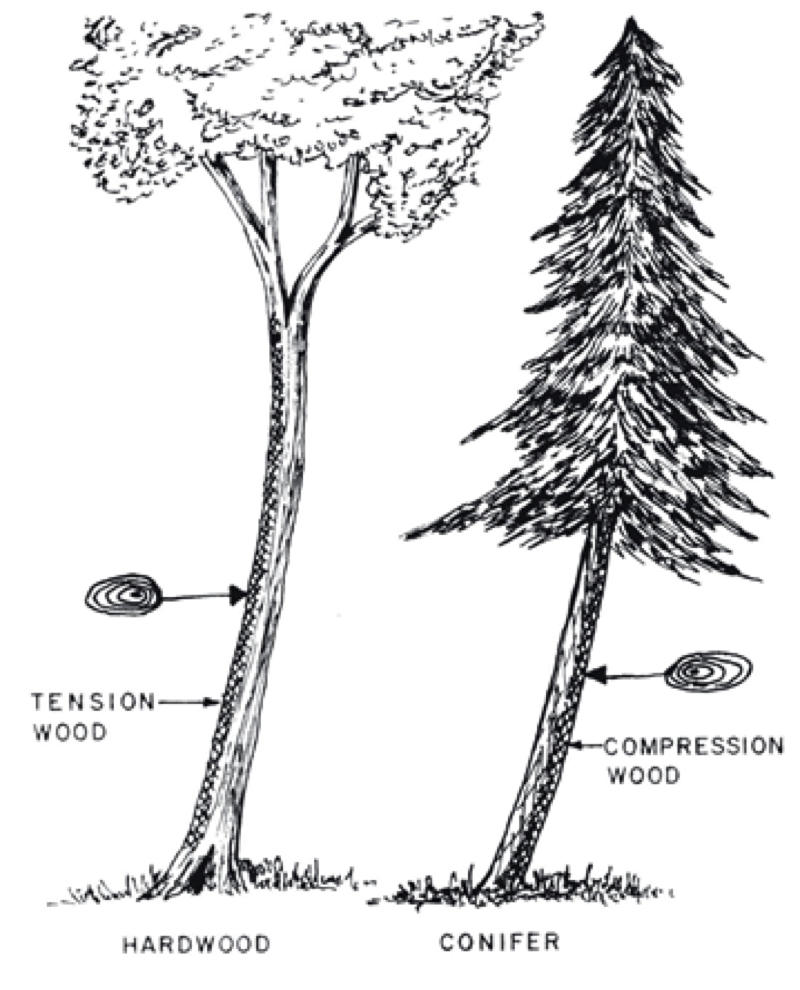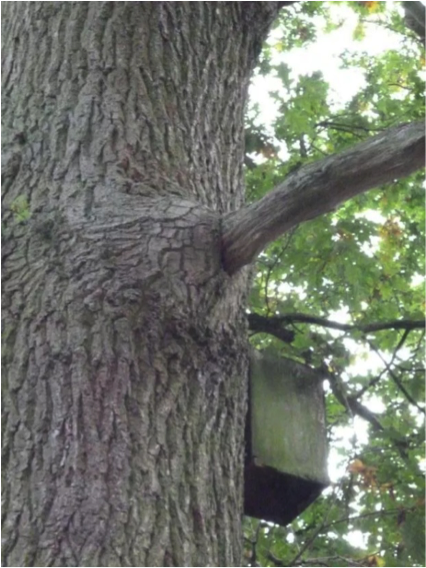Tree Defects and Biomechanics
This two part blog has been provided by the students at the Gardens at HCP, we hope you enjoy it!
Part 1 by: Cassidy Ash
On February 28, 2019 we had Gordon Mackay come in and explain to the class the defects of a tree and the biomechanics. He explained to us all the different kinds of defects in a tree, the types of wood that cause major stress in trees and the biomechanics along with some other interesting strategies.
Tree defects are when a part of the trees structure is weakened by sudden trauma or the result of wood deterioration causing the tree to fail. What people mostly see in trees is co-dominant stems or recognized as the “v” formation or a fork which is a danger to people because in a fork the bark builds up in the middle (included bark) causing pressure and eventually splitting of the tree. Other tree defects are:
- Lack of lower branches which is a form of slenderness in a tree. If a tree is to slender it will most likely sway more and not be able to hold up it own canopy causing stress and eventually failure.
- Fungal attacks/ decay in root and stem. This is also one of the most common causes of failure in a tree, trunks and roots with decay is most likely the first place that the tree is going to fail.
- Wood creep is when the wood of a tree spreads because of temperature, moisture, direction, species, etc. This results in bending and cracking of the tree leading to potentially failure.
- lion-tailing pruning. This is the removal of all the branches except for the end branches on a important side branch connected to the main stem. This results in major stress and splitting.
- Excessive branch end weight. This caused stress and cracks in the tree branch.
- Summer branch drop. This is the sheading of limbs in the summer for no reason.
- Banana cracks. Banana cracks usually happen when the tree is shaped like a banana and a trauma (ex: wind) causes compression on the curved side causing the tree to crack on the curved side.
- Windthrow is when the wind tears the tree out of the ground.
- Cracks in the trunk.
- Root girdle. Root girdle is when the roots are planted and trapped in the container, not spread out when planted or stuck in a small space and wrap around each other, compressing one another, until it fails.
- Bulge wood. This is when wood is bulging out of the tree.
- Helical crack. Helical crack is a crack caused by twisting of the trunk.

- Hazard-beam crack. This is when there's a crack in the middle of one of the main branches.
The types of wood are another factor that comes into play on the survival of a tree. The main types of wood that cause tremendous stress in a tree is compression wood, tension wood, and reaction wood.
- Compression wood is reaction wood that is on the lower side of branches and leaning trunks
- Tension wood is reaction wood that is on the upper side of branches and leaning trunks
- Reaction wood is wood that forms in the place of normal wood, gravity controls the type of wood its going to be.

Shedding Collar
Biomechanics is the mechanical behaviour of a tree. Arborists and horticulturalist take the knowledge of how a tree works into consideration when measuring and pruning a tree. Gordon went over multiple tips and tricks to ensure the safety of the tree and people who may be around it. Some of them are:
- Measurement of a tree: To measure the height of a tree you must take a pen and hold it out to the tree backing up till the pen's width matches the trees and the top of the pen matches the top of the tree. Turn the pen and measure the length from you to the tree, that's the height of the tree.
- To tell if a tree is alive or not: You take a rubber hammer and bang it against the tree, if it sounds hallow it's dead.
- Shedding collar: A branch that is dead in nature and the collar is protecting the stem. Don't cut into the collar.
There are many reasons for tree defects, and here, we will review some main defects introduced, affecting trees. Also to be
 discussed are biomechanical reasons for tree failures and defects.
discussed are biomechanical reasons for tree failures and defects.Some tree defects can be structural, and others are accidental, causing traumatic injury such as vehicle impact or result of horticulture work. This can be detrimental to tree health. Other defects are completely out of our control such as fungal decay, insects or disease.
Following, will be describe some of the more common structural tree defects and also mention 7 deadly defects that should not be left ignored.
Structural Failures
● Co-dominant stems
Two stems that are growing too closely together causing weak unions and inevitable splitting, breakage and entry for rot and disease.
● Root System Issues
The inability of the root system to develop sufficiently to resist strong winds, or restricted root conditions, waterlogging, disease.
● Lion tailing
Pruning which can lead to splitting due to transverse stresses and other problems. Canopy weight not evenly distributed and too much pressure is on the heavier branches.
● Life belt / Bulge wood
Localised wood failure can lead to formation of “life belts”. They produce a step-wide contour line.
● Hazard beam
Curved woody loading tends to bend branches against the direction of curvature. This could lead to splitting horizontally through the center. Such cracks are often highly dangerous.
● Lack of lower branches - Axiom of uniform stress
Having lower branches maintains uniform stress distribution throughout the length of a tree trunk. With lower branches the tree's form is more cone like. Removing the lower branches, creates a smaller, long cylinder, to a small crown. This reduces the trees ability to remain upright in windy and inclement weather and creates other dangers.
● Excessive branch weight / banana crack / Helical cracks (shear)
Result of opposing forces moving in different directions causing twisting, shearing or compression forces, damaging the fibers of the wood and causing external cracks. These cracks then contribute to weak structures and failure points in the tree. (Shear is the mechanical stress tending to make one part of a solid slide past one another)
● Reaction wood
Wood with atypical anatomy that grows in a region of the tree that experiences high mechanical stresses. Reaction wood is relatively strong in compression (conifers) or tension (deciduous) to resist these stresses.
7 Deadly Defects
- Decay
- Cracks
- Root problems
- Weak branch union
- Trunk cankers
- Poor tree architecture
- Dead wood
A model of wound reactions/ natural defence by the tree to protect itself. The process that the tree uses can be described in terms of Walls of defence. Each wall provides some kind of action or reaction to protect the tree from decay, insects or infections. These 4 walls resist - create walls against infections - in all four directions from the wound.



